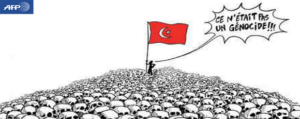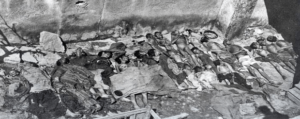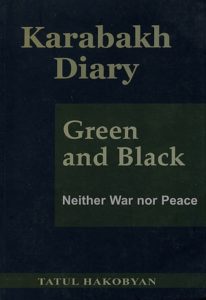
Armenian-Azerbaijani clashes, ethnic cleansings and pogroms; November 22-23, 1988
January 13, 2020 – History Diary – Artsakh Diary: «««Crimes of the Republic of Azerbaijan against the Armenian people, against humanity and civilization, over the past 100 years»»»
After the massacre in Sumgait, Armenian-Azerbaijani clashes and ethnic cleansings accompanied by pogroms were inevitable. From September 18-20, 1988, the Armenian population was forced to abandon Sushi; the Azerbaijanis, Stepanakert.
In Baku, public meetings studded with anti-Armenian speeches had been taking place since February 21, 1988, when a group of students held a small protest in front of the Central Committee building of the Communist Party of Azerbaijan. Later, a series of small public meetings, (when compared to the Yerevan rallies in the hundreds of thousands), had taken place close to the Academy of Sciences of Azerbaijan. The first large rally took place in Lenin Square on May in which around 15 thousand people participated; mostly laborers and students.
“All the participants were contemptuous of the Karabakh separatists. Those speakers who threatened or insulted Armenians were applauded. Those who tried to calm the people and assure them that the leadership of the republic was resolute and capable of responding in kind were jeered and whistled at. That was the first time that laborer Neymet Panahov, the ‘nightingale of the square’, appeared publicly,” writes Zardusht Alizade, Azerbaijani politician.

The pretext for the rally on November 17, 1988, in Lenin Square was the rumor that a holiday home was to be built in Sushi for workers of the aluminum factory in Yerevan. That disinformation was pure provocation. For two days, the main figure in the square had been Enver Aliyev, an employee in the Geography Institute of the Academy of Sciences. They beat and ejected him from the square on the evening of November 18 and then arrested him. From November 19, a 26-year old lathe operator, Neymet Panahov, took the reins of leading the rallies in his hands.
“An analysis of the eighteen days of rallies confirms that the main aim of the organizers was not the defense of Karabakh, but the discrediting and dismissal of Vizirov,” writes Alizade.
During the Baku rallies Lenin Square, the chants “Gha-ra-bagh” rang out and patriotic songs were sung by the tens of thousands of demonstrators. They demanded the “liberation of Azerbaijani soil from extremists and Armenians”. Another demand was “Either give Azerbaijanis in Armenia the right of self-governance or take away Karabakh’s self-governance.” On the other side of the square hung a portrait of Ahmed Ahmedov who had received the maximum sentence for his role in the Sumgait crimes. A state of emergency was announced in Baku, Ganja (Kirovabad) and Nakhijevan starting on November 23.
On November 22 and 23, 1988, massacres of Armenian begin in Baku, Kirovabad, Shamakhi, Shamkhor, and Mingechaur, from where the last Armenians were evicted. This time, the Armenian response was commensurate. In some districts, particularly Gugark, unarmed civilian Azerbaijanis were killed.
In an extraordinary session, the Soviet Armenian Parliament adopted a decision that only the laws approved by the Supreme Council of Armenia would have the force of law in the republic. Moscow considered this unlawful and unconstitutional. Yerevan declared a state of emergency and Azerbaijanis were killed from November 17-19. Earlier in May, Azerbaijanis in the Ararat region had been subjected to violence and around a thousand Azerbaijanis had been forced to flee.
Armenian-Azerbaijani clashes had taken place in the Masis region around June and July of 1988. It must be stated, that contrary to the Armenians in Azerbaijan, by November the majority of approximately 160,000 Azerbaijanis living in Armenia had exchanged, sold or received compensation for their apartments. According to some data, a few thousand Azerbaijanis changed their ‘ov’ or ev’ surnames and remained in Armenia. Prior to the earthquake of December 7th, almost all Azerbaijanis had been driven out of or had left Armenia and, with the exception of Baku, mostly all the Armenians from Azerbaijan. How many Armenians were killed in Azerbaijan during clashes and deportation, and how many Azerbaijanis were killed in Armenia, remains contentious.

The 1992 interim report of the CSCE (Conference on Security and Co-operation in Europe), the successor of the Organization for Security and Co-operation in Europe (OSCE) states, “About 9 months after the Sumgait events, the eviction or emigration of Azerbaijanis from Armenia had ended. There are conflicting claims of the numbers killed during the deportations of the Azerbaijanis. Azerbaijani refugees insist that over 160 people were killed, while Armenia insists that the number does not exceed 25 and that those responsible have been charged. In 1988, Armenians in Gyanja were massacred at least on two occasions and dozens were killed. The most vicious attacks, which resulted in the callous killings of Armenians, took place in January 1990 in Baku. The numbers killed, according to different sources, ranges from 60 to over 100.”
In 1991, Azerbaijani investigator Arif Yunusov wrote in the Russian Express Khronika that 215 Azerbaijanis had been killed in Armenia. In response, Husik Harutiunyan, head of the Soviet Armenia’s KGB, insisted that the number of Azerbaijanis killed in Armenia was twenty five.
Yunusov wrote that the attacks on the Azerbaijanis were also led by KGB employees. He even mentions the surname of the Deputy Head of the KGB, Mehrabyan. However, there has never been a deputy head with that surname. According to Harutiunyan, most of the violence against Azerbaijanis in Armenia began in November of 1998 in the northern regions where large numbers of attacked and looted Armenians, mainly from Kirovabad, had arrived via Georgia. “This explains why 20 of the 25 dead Azerbaijanis were killed in those regions, and the majority of these were killed in the district of Gugark, northern Armenia,” explains the head of the Soviet Armenia’s KGB.
Vadim Bakatin, Interior Minister of the Soviet Union, visited Armenia and Azerbaijan towards the end of 1988 to try and end the deportations. Bakatin met the terrified Azerbaijanis and Armenians in Spitak and Kirovabad. They requested help and protection, something already beyond Bakatin’s power. He instructed the interior ministers of the two republics to ensure that the refugees do not suffer.
“The local leadership disputed all the allegations, promised to sort things out, but I no longer believed that they would do anything. And there were few people here that I, as a minister, could depend on. You can’t sack everybody”, writes Bakatin.

www.aniarc.am/2020/01/13/armenian-azerbaijani-clashes-ethnic-cleansings-and-pogroms-november-22-23-1988/
